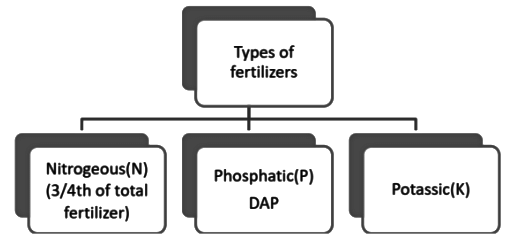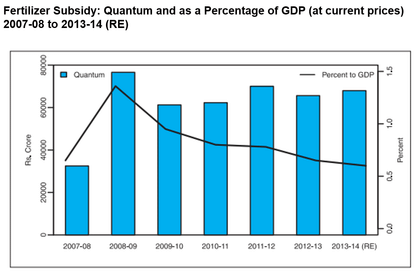Fertilizer: Determinants of Agriculture | Agriculture Optional for UPSC PDF Download
| Table of contents |

|
| Fertilizer |

|
| Problems in Fertilizer Sector |

|
| Steps for Improvement of Fertilizer Sector |

|
| Vermicomposting |

|
Fertilizer
- During the Green Revolution, the introduction of High Yielding Variety (HYV) seeds led to a significant increase in the demand for fertilizers.
- Fertilizers are soil amendments used to promote plant growth.
- Indian soils, after being used for agriculture for thousands of years, have exhausted their natural fertility, resulting in low productivity.
- To address this issue, manure and fertilizers are necessary to restore the soil's capacity to produce good yields.
- The combination of HYV seeds, fertilizers, irrigation, and technology has led to unprecedented growth in agricultural production in India.
- Fertilizer consumption is an indicator of agricultural prosperity, as 70% of the growth in agricultural production can be attributed to increased fertilizer application.
Benefits of Fertilizers
- Increased Farm Production: Fertilizers allow for high cropping intensity and are essential for the successful cultivation of high-yielding varieties (HYVs) of seeds.
- Soil Nutrient Requirements: Deccan (or Lateritic) soil requires more phosphorus (P) and potassium (K), while Alluvial soil needs additional nitrogen (N), all of which can be supplied through fertilizers.
- Specific Crop Needs: Regions like Maharashtra and Karnataka, known for sugarcane cultivation, require higher levels of potassium (K), which can be provided by fertilizers.

Production and Consumption of Fertilizers in India
- India is the 3rd largest producer of fertilizers, following China and the United States.
- It is also the 2nd largest consumer of fertilizers, after China.
- The production of all fertilizers (NPK) in India has increased from 1,059 thousand tonnes in 1970-71 to 16,092 thousand tonnes in 2013-14, marking more than a 15-fold increase in 4.5 decades.
- The average fertilizer consumption in India is 165 kg/ha of NPK, but there are significant variations between states.
- Uttar Pradesh is the largest consumer of fertilizers, using 4,207 thousand tonnes per year.
- Andhra Pradesh and Maharashtra each consume more than 3,000 thousand tonnes of fertilizer annually.
- North-Eastern India is the least dependent on chemical fertilizers.
Per Hectare Consumption of Fertilizers
- Despite significant progress in production and consumption of fertilizers, India lags behind several countries in terms of fertilizer consumption per hectare.
- Countries like Pakistan, China, and Bangladesh have higher per hectare fertilizer consumption than India.
- Most European countries, along with Egypt, Chile, Japan, and New Zealand, use much larger quantities of fertilizer per hectare compared to India.
Problems in Fertilizer Sector
Low Fertilizer Consumption: India has a low average fertilizer consumption of 165 kg/ha, which is significantly lower than that in many other countries. This is attributed to several factors:
- Lack of Awareness: Farmers may not be fully aware of the benefits and proper use of fertilizers.
- Distribution and Supply Issues: There are problems with the distribution system and overall supply of fertilizers.
- Irrigation Facilities: The lack of adequate irrigation facilities contributes to under-application of fertilizers.
- Cost of Chemical Fertilizers: Chemical fertilizers can be expensive, making them unaffordable for poor farmers.
Imbalance in Fertilizer Use: There is a significant imbalance in the use of different types of fertilizers across various regions, seasons, crops, soils, and regions.
- Types of Fertilizers: Ideally, the use of fertilizers should follow a 4:2:1 ratio as per the Haumantha Rao committee. However, the current usage is 8.2:4.2:1, indicating a skewed pattern.
- Seasons: More fertilizer is used in the Rabi season compared to the Kharif season, partly due to the uncertainty of monsoon rainfall.
- Crop Requirements: Different crops have varying nutrient needs. There is high fertilizer usage for crops like rice, wheat, and sugarcane, often in conjunction with high-yielding variety (HYV) seeds and irrigation. In contrast, the usage is low for pulses, coarse grains, and oilseeds.
- Soil Types: Fertilizer requirements differ based on soil type. For example, soils with good organic matter may require less fertilizer. States like Sikkim have adopted organic farming practices to reduce fertilizer use.
- Regional Variations: States such as Punjab, Andhra Pradesh, Haryana, and Uttar Pradesh have high fertilizer usage. Within states, certain districts with better irrigation facilities and the use of HYV seeds also show high fertilizer usage.
Urea Production and Usage: There is a high production and usage of urea due to substantial government subsidies. Urea is not part of the Nutrient Based Subsidy scheme.
Neglect of Other Nutrients: Other soil nutrients are often neglected, leading to a depletion of micronutrients due to the monocultural use of nitrogen, phosphorus, and potassium (NPK) fertilizers.
Cow Dung as Manure: Cow dung is considered one of the best natural manures. However, its use is limited because it is often used as a kitchen fuel in the form of dung cakes, due to a decrease in firewood supply and increased fuel demand in rural areas.
 Nitrate Pollution: There are increasing concerns about nitrate pollution in soil and water, which leads to eutrophication, characterized by algal blooms.
Nitrate Pollution: There are increasing concerns about nitrate pollution in soil and water, which leads to eutrophication, characterized by algal blooms.
Indigenous Production of Fertilizers: India needs to produce 80% of its urea requirement domestically, but the country is still largely dependent on imports for fertilizers.
Imbalance in Fertilizer Usage: There is a significant imbalance in the usage of different fertilizers, with urea accounting for 57% of usage, di-ammonium phosphate (DAP) at 17%, and muriate of potash (MOP) at 6%.
Government Policies: To meet the requirements for potassic (K) and phosphate (P) fertilizers, the government has notified a new investment policy in 2012 to encourage indigenous production and reduce import dependence.
Subsidy Schemes: The Nutrient Based Subsidy scheme provides fixed subsidies for P and K fertilizers based on their nutrient content.
Steps for Improvement of Fertilizer Sector
- There is a vast potential for utilizing rural and urban compost, which can serve the dual purpose of waste disposal and providing manure to the soil.
- The government has offered significant incentives, particularly in the form of heavy subsidies for chemical fertilizers, leading to a substantial increase in fertilizer consumption.
- To maintain fertilizer quality, approximately 52 quality control laboratories have been established across the country.
- The Central Fertilizer Quality Control and Training Institute in Faridabad, along with three regional centers in Mumbai, Kolkata, and Chennai, plays a crucial role in ensuring fertilizer quality.
- The Fertilizer Control Order, issued under the Essential Commodity Act of 1953, regulates the trade, price, quality, and distribution of fertilizers. This order prohibits the manufacture, import, and sale of fertilizers that do not meet prescribed standards.
Soil Testing Facilities: The Soil Health Card Scheme has been launched to promote soil testing with features such as:
- Cards displaying soil fertility and recommended fertilizers based on soil and crop requirements.
- Deployment of 100 mobile testing labs.
- Issuance of approximately 14 crore cards in the next three years.
- The theme of the Soil Health Card Scheme is “Swasth Dhara, Khet Hara.”
Mrid Aparikshak Scheme: This initiative offers digital mobile soil test kits to assess various soil parameters such as pH, NPK, and micronutrients. Farmers receive essential information via SMS.
- Promotion of organic measures such as cattle dung, urban compost, sewage sludge, and green manure.
- Encouragement of biofertilizers, including microorganisms that fix atmospheric nitrogen or enhance nutrient solubility, such as blue-green algae and Rhizobium.
- Government should import fertilizers from cost-effective sources like Ukraine and increase consumption in low-use areas through subsidies.
- Equitable distribution of fertilizers to address regional, seasonal, and crop disparities.
- Training and demonstration on balanced fertilizer use.
- Inclusion of urea in the National Beneficiary Scheme (NBS) for phosphate and potash.
- Promotion of neem-coated urea.
- Fertigation: The practice of applying fertilizers along with irrigation.
Vermicomposting
Vermicomposting is a method of breaking down organic matter with the help of earthworms. This process produces water-soluble, nutrient-rich, and moist organic fertilizers. Vermicomposting enhances soil aeration and enriches the soil with beneficial microorganisms, leading to improved root growth in plants. Additionally, it is an affordable and easy method of producing high-quality organic fertilizers.
- Vermicomposting involves the decomposition of organic material by earthworms, resulting in nutrient-rich, water-soluble, and moist organic fertilizers.
- This process enhances soil aeration and enriches the soil with beneficial microorganisms, which are essential for plant health.
- Vermicompost improves root growth in plants, leading to healthier and more robust plants.
- One of the advantages of vermicomposting is that it is easy to produce and can be done in an affordable manner.
Neem Coated Urea And Its Benefits
- Neem Coated Urea is a natural alternative to chemical inhibitors for urea release in soil.
- Coating urea with neem oil or neem cake slows down urea release, allowing plants to absorb nutrients gradually.
- This results in higher crop yields with less urea usage and reduces underground water contamination.
- Neem also acts as a natural insecticide, and collecting neem seeds for this process generates rural employment and income for farmers.
- Additionally, neem coating helps prevent urea pilferage and eutrophication.
Difference Between Plain Urea and Neem Coated Urea
- Neem coated urea involves adding a layer of neem over plain urea, enhancing soil fertility and crop production.
- The neem oil coating in Neem coated urea mixes slowly with the soil, allowing crops to absorb it as needed.
- This prevents excess urea from being washed away or released into the air as nitrogen.
- In contrast, plain urea often leaves a significant portion unused, leading to wastage.
|
52 videos|224 docs
|




















